Related Research Articles
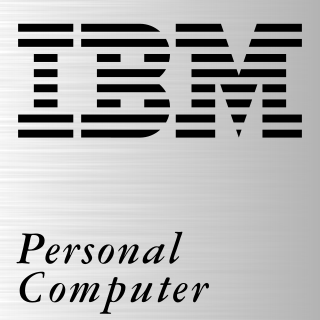
The IBM Personal Computer is the first microcomputer released in the IBM PC model line and the basis for the IBM PC compatible de facto standard. Released on August 12, 1981, it was created by a team of engineers and designers at International Business Machines (IBM), directed by William C. Lowe and Philip Don Estridge in Boca Raton, Florida.
Kaypro Corporation was an American home and personal computer manufacturer based in Solana Beach in the 1980s. The company was founded by Non-Linear Systems (NLS) to compete with the popular Osborne 1 portable microcomputer. Kaypro produced a line of rugged, "luggable" CP/M-based computers sold with an extensive software bundle which supplanted its competitors and quickly became one of the top-selling personal computer lines of the early 1980s.
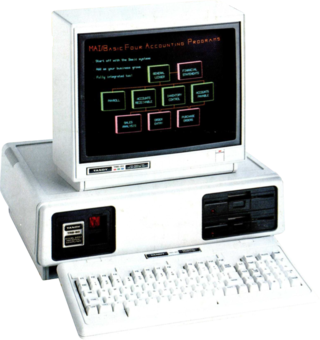
The Tandy 2000 is a personal computer introduced by Radio Shack in September 1983 based on the 8 MHz Intel 80186 microprocessor running MS-DOS. By comparison, the IBM PC XT used the older 4.77 MHz Intel 8088 processor, and the IBM PC/AT would later use the newer 6 MHz Intel 80286. Due to the 16-bit data bus and more efficient instruction decoding of the 80186, the Tandy 2000 ran significantly faster than other PC compatibles, and slightly faster than the PC AT. The Tandy 2000 was the company's first computer built around an Intel x86 series microprocessor; previous models used the Zilog Z80 and Motorola 6809 CPUs.
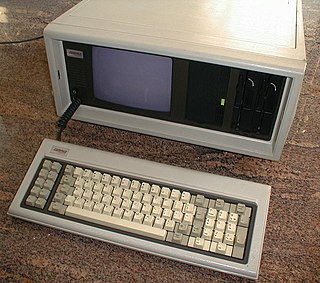
The Compaq Portable is an early portable computer which was one of the first IBM PC compatible systems. It was Compaq Computer Corporation's first product, to be followed by others in the Compaq Portable series and later Compaq Deskpro series. It was not simply an 8088-CPU computer that ran a Microsoft DOS as a PC "work-alike", but contained a reverse-engineered BIOS, and a version of MS-DOS that was so similar to IBM's PC DOS that it ran nearly all its application software. The computer was also an early variation on the idea of an "all-in-one".

The Pivot is a family of early IBM PC–compatible portable computers first released in 1984 by Morrow Designs, a company founded by George Morrow. It was the first lunchbox-style portable computer, with a vertically configured case that has a fold-down keyboard. The only external component is a single AC adapter. It would have been a little top heavy except for the large camcorder-style battery loaded into its base. The Pivot was designed by Chikok Shing of Vadem Inc.

The Rainbow 100 is a microcomputer introduced by Digital Equipment Corporation (DEC) in 1982. This desktop unit had a monitor similar to the VT220 and a dual-CPU box with both 4 MHz Zilog Z80 and 4.81 MHz Intel 8088 CPUs. The Rainbow 100 was a triple-use machine: VT100 mode, 8-bit CP/M mode, and CP/M-86 or MS-DOS mode using the 8088. It ultimately failed to succeed in the marketplace which became dominated by the simpler IBM PC and its clones which established the industry standard as compatibility with CP/M became less important than IBM PC compatibility. Writer David Ahl called it a disastrous foray into the personal computer market. The Rainbow was launched along with the similarly packaged DEC Professional and DECmate II which were also not successful. The failure of DEC to gain a significant foothold in the high-volume PC market would be the beginning of the end of the computer hardware industry in New England, as nearly all computer companies located there were focused on minicomputers for large organizations, from DEC to Data General, Wang, Prime, Computervision, Honeywell, and Symbolics Inc.

The Gavilan SC is an early laptop computer first released by the Gavilan Computer Corporation in April 1984. The computer ran on an Intel 8088 microprocessor running at 5 MHz and sported a touchpad for a pointing device, one of the first computers to do so. The laptop was developed by Manuel "Manny" Fernandez, founder of the Gavilan Computer Corporation, and unveiled in May 1983.

The Sharp PC-5000 was a pioneering laptop computer, announced by Sharp Corporation of Japan in November 1983. It employed a clamshell design in which the display closes over the keyboard, like the earlier GRiD Compass and contemporary Gavilan SC.
The Commodore PC compatible systems are a range of IBM PC compatible personal computers introduced in 1984 by home computer manufacturer Commodore Business Machines.
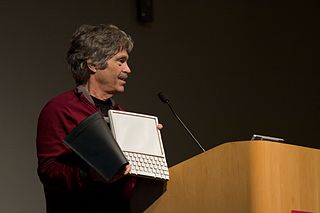
The history of laptops describes the efforts, begun in the 1970s, to build small, portable personal computers that combine the components, inputs, outputs and capabilities of a desktop computer in a small chassis.
The MBC-550 series, also known as the MBC-550/555, is a series of personal computers sold by Sanyo. It was unveiled at the COMDEX/Spring '83 in April 1983 and first released to market in March 1984. All models in the MBC-550 series featured pizza-box-style cases and Intel 8088 microprocessors and run versions of MS-DOS. On its release in 1984, the MBC-550 was the least expensive IBM PC compatible released to date, at a price of US$995. The MBC-550 series followed Sanyo's MBC-1000 line of CP/M computers.
North Star Computers Inc. was an American computer company based in Berkeley, California existing between June 1976 and 1989. Originally a mail order business for IMSAI computers, it soon developed into a major player in the early microcomputer market, becoming first known for their low-cost floppy disk system for S-100 bus machines, and later for their own S-100 bus computers running either the CP/M operating system or North Star's own proprietary operating system, NSDOS. North Star BASIC was a common dialect of the popular BASIC programming language. They later expanded their lineup with dual-CPU machines able to run MS-DOS, and a server version running either DOS or Novell NetWare.
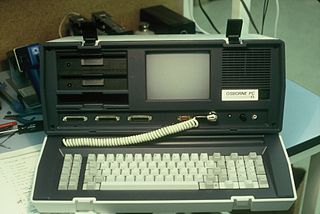
The Osborne PC is an unreleased IBM PC–compatible personal computer developed between 1983 and 1984 by Osborne Computer Corporation. Only prototypes of the computer were ever produced.
The Texas Instruments Professional Computer and the Texas Instruments Professional Portable Computer (TIPPC) are personal computers produced by Texas Instruments that were both released on January 31, 1983, and discontinued around 1985; the TIPC is a desktop PC and the TIPPC is a portable version that is fully compatible with it. Both computers were most often used by white-collar information workers and professionals that needed to gather, manipulate and transmit information.

The Sharp PC-7000 is a luggable portable computer released by Sharp Electronics in 1985. The PC-7000 was Sharp's second entry into the IBM PC-compatible portable computer market, their first being the PC-5000.
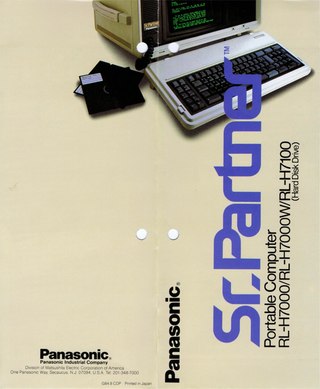
The Senior Partner is an IBM PC-compatible portable computer that was introduced by the Panasonic Corporation in 1984. Weighing roughly 31 pounds (14 kg) in its base configuration, the computer came equipped with a cathode-ray tube display and a built-in thermal printer.

The Executive Partner is an IBM PC-compatible portable computer that was introduced by the Panasonic Corporation in 1985. The portable computer is AC-powered exclusively, weighs between 28 and 30 pounds (14 kg), and features a built-in printer. The Executive Partner was one of the first affordable portable computers with a plasma display.
The MAD-1 is an IBM PC–compatible desktop computer released by Mad Computers, Inc., of Santa Clara, California, in 1984. The computer was noted among the technology press for its unique, modular design and its 80186 microprocessor, the latter seldom used in PC compatibles. It received positive reviews but sold poorly and was pulled from market a year later.
Pronto Computers, Inc., was an American computer company based in Torrance, California, active from 1983 to 1987. During its brief existence, the company released a duo of IBM PC compatible computer systems and a family of high-spec graphics cards. Pronto's first product, the System 16, was widely lauded for its graphical prowess and industrial design; in 1983, I.D. magazine named it the best-designed product in the field of instrumentation and equipment. The System 16 was followed up with the Pronto Transportable Solution, a portable computer. Both it and the Pronto 16 ran the Intel 80186, a microprocessor seldom used in IBM PC compatibles. Pronto Computers went bankrupt shortly after the Black Monday financial crisis of 1987.
CompuSource Compatible Systems Inc. was a short-lived privately held American computer company active in the 1980s and based in Minneapolis. It sold a variety of clones of the Apple II, including one portable that was also an IBM PC compatible and a CP/M machine.
References
- 1 2 Sandler, Corey (December 1983). "The Prognosticators Pronounce: Future Complications on the PC". PC Magazine. 2 (7). Ziff-Davis: 248–257 – via Google Books.
- 1 2 Staff writer (November 1982). "Portable microcomputer". Infosystems. 29 (11). Reed Business Information: 86 – via the Internet Archive.
- ↑ Haggerty, C. (March 14, 1983). "Computer Devices Launches Network to Distribute New Portable Computer". Computer Systems News (115). UBM LLC: 80 – via Gale.
- ↑ Staff writer (October 20, 1982). "Lyle's Computer Devices Leapfrogs into Systems". Electronics. 55. Endeavor Business Media: 15 – via Gale.
- ↑ Staff writer (November 2, 1983). "Computer Devices: Its Chapter 11 Step". The New York Times: D5. Archived from the original on February 2, 2023. ProQuest 424823928.
- 1 2 3 Solomon, Abby (June 1984). "Gone, But Not Forgotten". Inc. 6. Mansueto Ventures: 166. Archived from the original on February 2, 2023 – via Gale.
- ↑ McWilliams, G. (August 1, 1983). "Comp. Devices Lays Off 83 to Counter Projected Loss". Electronic News. 29 (1456). Sage Publications: 21 – via Gale.
- ↑ Staff writer (November 1983). "Smaller Computer Devices". Portable Computer. 1 (5). McGraw-Hill: 13 – via Gale.
- 1 2 Kranish, Michael (February 20, 1986). "Computer Devices' reorganization OK'd". The Boston Globe: 63 – via Newspapers.com.
- ↑ Staff writer (January 27, 1989). "Computer Devices acquires firm". The Boston Globe: 24 – via Gale.
- ↑ "Computer Devices Announces Change in Business Strategy, Suspends Internal Operations". PR Newswire. October 2, 1998 – via ProQuest.